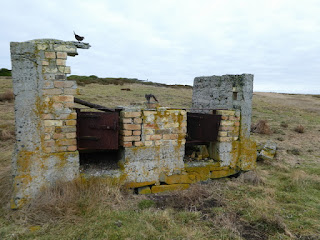
By the way, I should say I am incredibly flattered that many people around the world look at this blog. It was only started as a means to let friends back in the UK know what we were up to in the South Atlantic, but I now see from recent statistics that I have readers all over the place! Below is a list of the Top Ten countries by views in the last week -
United Kingdom
Ireland ("Hello, Ireland!" Where have you been?)
United States
Falkland Islands
Russia
France
Germany
India
Ukraine
Argentina
If I look at the views per month, St Helena and Cayman Islands, two remote British Overseas Territories, also feature. So, "Hello" to you guys, too, and anyone else that reads this.
Enough waffle. We had booked our flight on FIGAS, a government air taxi service. Our checkin was at 11am, so in the morning we packed and left the house about 10:50! We and our bags were weighed, and we took off about 11:30, after waiting on the apron while two RAF Typhoon jets completed their Saturday morning exercises above the runway!
 |
| Typhoons at 11 o'clock |
 |
| Looking west over Stanley Harbour. |
 |
| Within 5 minutes walk of our Lodge |
This guy wobbled back into the sea when he saw us, and we thought we had frightened him.....
Far from it. He followed us for about a mile, along the whole length of the beach, swimming parallel to us just a few yards offshore.
We passed huge colonies of Gentoo penguins that are resident all year round, and then headed through the sand dunes to see who else had arrived.
 |
| Female seal making use of the shelter |
The seals are monitored by a team of Italian scientists, who spend six months of the year on the Island counting, weighing and observing the seals. More information and fantastic photos can be found at their Facebook page -
https://www.facebook.com/eleseal.org/?fref=ts
We soon came across some big boys dozing in the dunes.
And the scientists were trying to take tissue samples or, if they recognised the seal, spraying their "name" on them, to make them easy to identify as they roam the beaches in coming weeks.
 |
| Scientists on a log watching a seal shelter... |
 |
| Nice teeth |
 |
| There were also some vantage points above the beach if you wanted to get close. I relied on a powerful zoom lens.... |
 |
| Female emerging from the sea, and me avoiding getting between the male and female..... |
 |
| The male showing an interest in the new female.... |
 |
| How would you like to wake up next to this? |
But Sea Lion Island has so much more. In the 1850s, when fur seals were almost extinct due to the actions of the sealers, penguins became a target for their oil. This contraption above is the remains of where penguins were boiled down for their oil - 1 pint per penguin. Millions were killed in a few decades.
 |
| Flying Falklands Steamer Duck |
 |
| Flightless Falklands Steamer Duck |
But the birdlife has recovered and is spectacular, especially in Spring. Winter is still clinging on here, so we saw no Rockhopper penguins, or Skuas, but the resident birds were a delight.
 |
| Striated Caracara |
 |
| Sealions on Sealion Island |
 |
| Picnic, with Lodge in distance, and caracaras near. Sealions below. |
But while we enjoyed the show, the fearless Caracaras came ever closer, looking for food or anything they could steal.
Our Nordic Walking poles saved us a few times, as the birds tried to work our how to grapple with this new prey species they had found - us!
 |
| Circling the prey - us! |
 |
| Endemic Cobb's Wren |
 |
| Grooming |
 |
| Velociraptor? |
 |
| Snowy Sheathbill |
 |
| About to give birth to a 30kg pup..... |
What we did see was amazing. All too soon, a little Britten-Norman Islander arrived to take us back to Stanley
The sky was cloudless and the sea crystal-clear as we tried to spot dolphins or whales on the way home.
 |
| The Lady Elizabeth, stuck at the end of the harbour. Arrived 1912 |
Peter.


















No comments:
Post a Comment